
 |
Tea Clipper |
 |
| from TeaAntiques.com | ||
| Edition Forty Four |
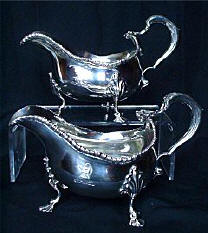 A truly magnificent pair of the very highest quality George III
Sterling silver sauce boats made by Jonathan Alleine in London in 1772. These
outstanding sauce boats are of a large size, of very heavy gauge silver and
are in remarkable condition. They have the most stunning bifurcated handle
terminations at the top of the handles at which point there is a beautiful
applied shell to the back of the sauce boat's body. This fantastic detail alone,
lifts these sauce boats into a special category of their own from the run of the
mill type sauce boats with open flying scroll handles.
A truly magnificent pair of the very highest quality George III
Sterling silver sauce boats made by Jonathan Alleine in London in 1772. These
outstanding sauce boats are of a large size, of very heavy gauge silver and
are in remarkable condition. They have the most stunning bifurcated handle
terminations at the top of the handles at which point there is a beautiful
applied shell to the back of the sauce boat's body. This fantastic detail alone,
lifts these sauce boats into a special category of their own from the run of the
mill type sauce boats with open flying scroll handles.
There are substantial and beautifully cast and applied feet to the sauce boat. Each of the three feet of the sauce boats is exquisitely formed with proud shells as the termination onto the body and with finely cast shell feet below a scroll ankle.
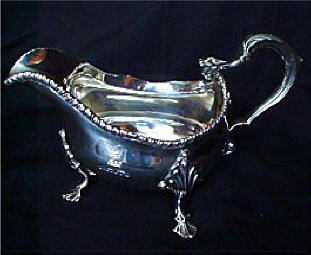
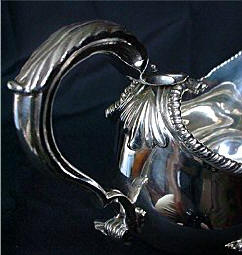
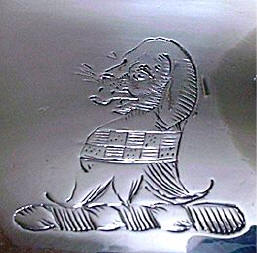
Both these amazing sauce boats have contemporary engraving on the left sides in the form of a crest of a long eared dog's head, with a chequered collar. The crests are extremely crisp and clear. They are both very clearly hallmarked underneath for 1772.
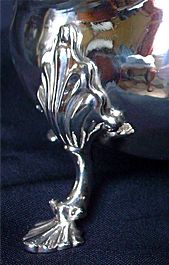
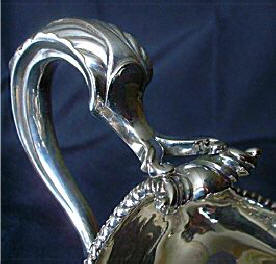
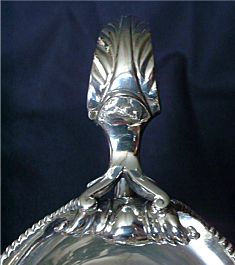
One of the very interesting features of the sauce boat is the way in which the handle terminates at the top. At the end of the leaf cap the handle breaks away into two arms (bifurcated) in the shape of a 'Y'. This giving a very firm, but delicate termination of the handle to the boat's body. The ends of the 'Y' have delicate inward turning scrolls which attach to the top shell scroll of the sauce boat's body.
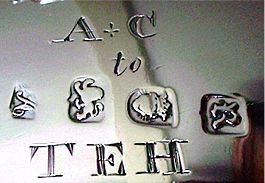 There
is a full set of large hallmarks on the base of the sauce boats, which comprises
the manufacturer's mark of 'JA'
(the 'J' of the mark not too visible because of the way in which the mark has
been side struck), in Italics for Jonathan Alleine; Lion Passant mark for
Sterling Silver; Crowned Leopard's head of the London Assay Office and the date
letter 'R' for 1772.
There
is a full set of large hallmarks on the base of the sauce boats, which comprises
the manufacturer's mark of 'JA'
(the 'J' of the mark not too visible because of the way in which the mark has
been side struck), in Italics for Jonathan Alleine; Lion Passant mark for
Sterling Silver; Crowned Leopard's head of the London Assay Office and the date
letter 'R' for 1772.
For quality they really are the top of the range as far as Georgian silver goes and a very good investment for the connoisseur collector of fine English silver from the Eighteenth century.
More details of this item and other tea related antiques can be found by visiting my web site at www.TeaAntiques.com.
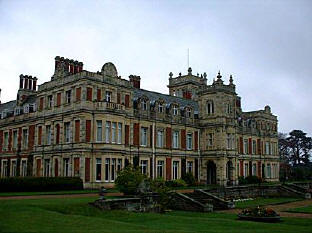 On a trip to Suffolk this summer, I took visit to a grand Victorian house in
Suffolk, Somerleyton Hall near Lowestoft. This attractive red brick and mellow
Caen stone built house has its origins back in the Jacobean period when it was a
manor house. It was later remodelled in the early nineteenth century
(c1844-1851), transforming it into a Hall that echoed the Jacobean architectural
features inside and having a look of an Anglo-Italian mansion on the outside.
On a trip to Suffolk this summer, I took visit to a grand Victorian house in
Suffolk, Somerleyton Hall near Lowestoft. This attractive red brick and mellow
Caen stone built house has its origins back in the Jacobean period when it was a
manor house. It was later remodelled in the early nineteenth century
(c1844-1851), transforming it into a Hall that echoed the Jacobean architectural
features inside and having a look of an Anglo-Italian mansion on the outside.
As well as the Hall itself, there are some fine gardens surrounding it, including open parkland, walled garden and formal beds stretching out in front of the Hall. On the North side of the Hall is a sunken garden, with central ornamental pond, this on the site of what had been a large glass 'winter garden', that alas was pulled down in the early twentieth century.
The estate is the ancestral home to Lord and Lady Somerleyton, although it has recently been handed over to their young son Hon. Hugh Crossley, while Lord and Lady Somerleyton have moved to a house within the estate.
There was a very friendly welcome to this house by the stewards, with a brief introduction into the history of the house and the current family. The house changes in the nineteenth century were carried out by the then owner Sir Morton Peto. He commissioned the finest Anglo-Italian architect of the period, John Thomas, to carryout the work. John Thomas had been the protégé of Sir Charles Barry and Prince Albert as architect, sculptor and ornamental mason, he had been responsible for work on the Houses of Parliament. His talent as ornamental sculptor can be seen in the design of Somerleyton's ornamentation.
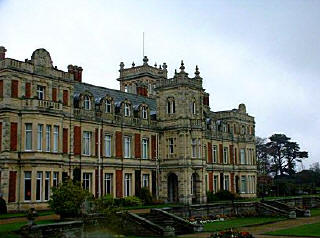 A tower built on one side of the Hall, much in the Victorian campanile style,
once housed a smoking room for the gentleman, which also doubled as an
observation room. Another tower on the skyline on the other side of the house
formed part of the stable block and houses within it a clock.
A tower built on one side of the Hall, much in the Victorian campanile style,
once housed a smoking room for the gentleman, which also doubled as an
observation room. Another tower on the skyline on the other side of the house
formed part of the stable block and houses within it a clock.
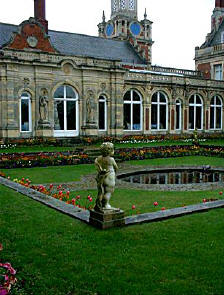 This clock is a
special one in that it was the work of Vulliamy, a famous clock maker.
This clock is a
special one in that it was the work of Vulliamy, a famous clock maker.
Sadly, after all the re-modelling work put into the house by Sir Morton Peto, he went bankrupt and was thus forced to sell the estate. It was then bought by the Crossley family in 1863, in whose ancestral hands it remains today. Sir Francis was created a Baronet in the same year that he bought Somerleyton Hall.
The first Crossley at the house was Sir Francis Crossley, who had bought the Hall from Sir Morton Peto. He was a carpet manufacturer from Halifax and from where he had gained his fortune, in a business established by his father. The three sons of Sir Francis also followed him into this carpet business, continuing this family run business. They were responsible for the innovation of steam driven looms for carpet weaving which allowed for the mass production of cheaper carpets, then now affordable to the less wealthy classes.
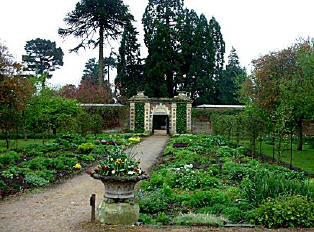
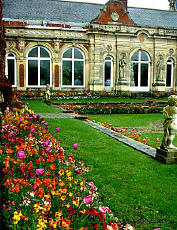
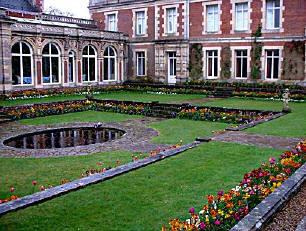
Several generations down, the title of Third Baronet was inherited by Savile Crossley, the third Lord Somerleyton in 1959. He held the position of Lord-in-Waiting to Her Majesty Queen Elizabeth II from 1978 and later the position as Master of the Horse to the Queen until he retired in 1991. On display in the house are many family treasures relating to these positions of high office, including many printed programmes for Royal state visits.
It is Sevile Crossley and his wife Belinda who have recently given over the estate up to their son, Hugh Crossley, and it will be interesting to see what changes he will make to the upkeep and running of this large estate.
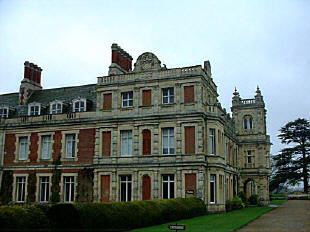 Visitors today enter the Hall from the North side into the Oak Room, which
used to be known as the North Drawing Room. There is heavy dark oak panelling
around the walls remaining from the earlier Jacobean Hall and there are some
craved wood fruit and flower panels by Grinling Gibbons. There is one very fine
piece of furniture that stood out in this room, this was a large Dutch bureau
bookcase. The frame of which was curvaceous and beautifully inlaid with brightly
coloured veneers, this I believe dating from the early eighteenth century.
Visitors today enter the Hall from the North side into the Oak Room, which
used to be known as the North Drawing Room. There is heavy dark oak panelling
around the walls remaining from the earlier Jacobean Hall and there are some
craved wood fruit and flower panels by Grinling Gibbons. There is one very fine
piece of furniture that stood out in this room, this was a large Dutch bureau
bookcase. The frame of which was curvaceous and beautifully inlaid with brightly
coloured veneers, this I believe dating from the early eighteenth century.
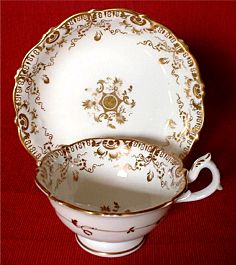 Following on from the Oak Room is the Library, its walls lined with books
within titled sections, these titles, such as 'history' of carved wood panelling
within the upper frieze of the bookcases. A pleasant room and quite light for a
Library with splendid views out across the formal gardens. It has a comfortable
appeal, with soft upholstered settees, a room in which it would be most restful
to sit reading a book taken from the shelves. There was also a tea tray set out
with Victorian teaset including cups and saucers decorated with scrolling
gilding, much like these from my own personal collection.
Following on from the Oak Room is the Library, its walls lined with books
within titled sections, these titles, such as 'history' of carved wood panelling
within the upper frieze of the bookcases. A pleasant room and quite light for a
Library with splendid views out across the formal gardens. It has a comfortable
appeal, with soft upholstered settees, a room in which it would be most restful
to sit reading a book taken from the shelves. There was also a tea tray set out
with Victorian teaset including cups and saucers decorated with scrolling
gilding, much like these from my own personal collection.
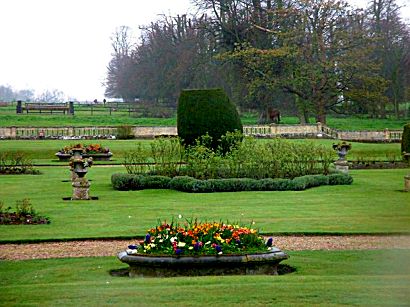 Next the Dinning Room, which also lies along the West side of the house,
again with fine views out across the formal garden. This room having light
custard yellow walls and a ceiling in light Adam style was the perfect setting
for an airy dining room. The walls of this room housed some fine and interesting
paintings. One of particular interest to me coming from Portsmouth where Lord
Nelson's flag ship HMS Victory remains, was a painting showing the Victory being
towed following the battle of Trafalgar in which Nelson died. This magnificent
painting, commissioned for Somerleyton was the work of Clarkson Stanfield. The
detailed painting shows HMS Victory being towed by what is believed to be HMS
Neptune into Gibraltar on 28th October 1805, seven days after the great battle
of Trafalgar. Victory with its masts and rigging in shreds from this fierce
battle.
Next the Dinning Room, which also lies along the West side of the house,
again with fine views out across the formal garden. This room having light
custard yellow walls and a ceiling in light Adam style was the perfect setting
for an airy dining room. The walls of this room housed some fine and interesting
paintings. One of particular interest to me coming from Portsmouth where Lord
Nelson's flag ship HMS Victory remains, was a painting showing the Victory being
towed following the battle of Trafalgar in which Nelson died. This magnificent
painting, commissioned for Somerleyton was the work of Clarkson Stanfield. The
detailed painting shows HMS Victory being towed by what is believed to be HMS
Neptune into Gibraltar on 28th October 1805, seven days after the great battle
of Trafalgar. Victory with its masts and rigging in shreds from this fierce
battle.
It was in the next room, the Staircase Hall, that I found something of immense, and certainly local interest, a stunning complete set of Lowestoft porcelain from the eighteenth century. Housed in a glass cabinet alongside the great oak staircase, this delightful locally made teaset was a joy to behold, especially it having so many pieces of the set including not just the globular teapot, its hexagonal stand and many tea bowls and saucers. But small covered milk jugs, lozenge shaped spoon tray, cake and bread and butter plate, etc. This very rare and fine Lowestoft teaset was one of the finest produced by the factory. It comes from a collection of Sir Samuel Hoare Bt. Each of the pieces in this set are decorated in a Chinese style with colourful flower sprays, the central motif of the pieces being a floral bouquet emanating from a fashionable cornucopia shaped vase. What an unexpected surprise to discover such a fine teaset from a factory only a few miles away from this Hall.
After working my way through the rest of this beautiful home, including the Entrance Hall, with its stuffed Polar Bears lurching up at you, the trophies of the first Lord Somerleyton's two man expedition to the Artic in 1897, through to the Ball Room and finally Conference Room.
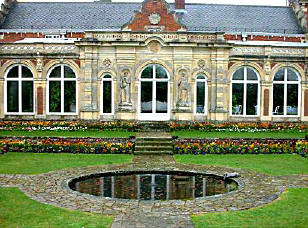 Leaving the house leads through to the tearoom/restaurant housed in the
glazed front of the remains of the old winter garden, what better place to sit
and enjoy some very fine refreshments, with views out over the sunken gardens
and on the wet day of my visit it could not have been a more welcoming warm
retreat.
Leaving the house leads through to the tearoom/restaurant housed in the
glazed front of the remains of the old winter garden, what better place to sit
and enjoy some very fine refreshments, with views out over the sunken gardens
and on the wet day of my visit it could not have been a more welcoming warm
retreat.
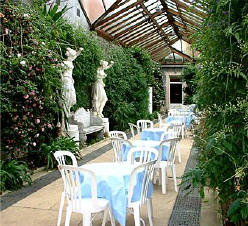 The food and service in this tearoom was both reasonably priced and
very good quality. I settled to have a ploughman's lunch, which was extremely
enjoyable. Not only did this come served with the traditional cheese, pickle,
salad and bread roll, but with several succulent slices of Ham. I did not have
room to try their scone cream tea or home made cakes, but I will certainly do so
on a subsequent visit to this lovely house and garden.
The food and service in this tearoom was both reasonably priced and
very good quality. I settled to have a ploughman's lunch, which was extremely
enjoyable. Not only did this come served with the traditional cheese, pickle,
salad and bread roll, but with several succulent slices of Ham. I did not have
room to try their scone cream tea or home made cakes, but I will certainly do so
on a subsequent visit to this lovely house and garden.
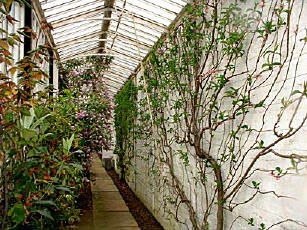 Finally, for the adventurous, there is a hedge maze within the gardens, but I
got lost even finding it! However, I did find the Victorian glass houses, in
which were some well trained peaches or Nectarines growing up the walls. I am
sure that in their heyday, these would have produced fine fruits for the house
dining table for grand dinner parties.
Finally, for the adventurous, there is a hedge maze within the gardens, but I
got lost even finding it! However, I did find the Victorian glass houses, in
which were some well trained peaches or Nectarines growing up the walls. I am
sure that in their heyday, these would have produced fine fruits for the house
dining table for grand dinner parties.
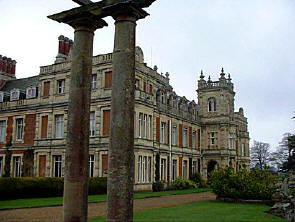 Somerleyton Hall
Somerleyton Hall
Lowestoft
Suffolk
NR32 5QQ
Tel: 08712224244
Fax: 01502 732143
Website: http://www.somerleyton.co.uk
Click here for
Map
Map courtesy of www.streetmap.co.uk
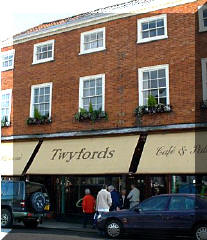
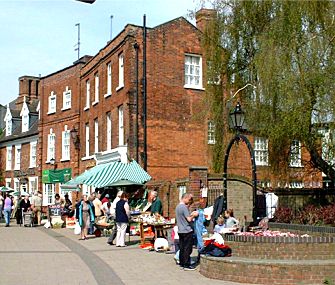 Within the pretty
market town of Beccles, Suffolk is a fine tearoom called Twyfords. The tearoom
is housed in what used to be a gentleman's outfitters prior to 1905. Inside,
they have kept a few reminders of this, by using one of the old counters as a
service counter for the café.y
Within the pretty
market town of Beccles, Suffolk is a fine tearoom called Twyfords. The tearoom
is housed in what used to be a gentleman's outfitters prior to 1905. Inside,
they have kept a few reminders of this, by using one of the old counters as a
service counter for the café.y
There is a good selection of cakes and creamy gateaux, but I had a fruit scone and jam. The service was extremely efficient and friendly.
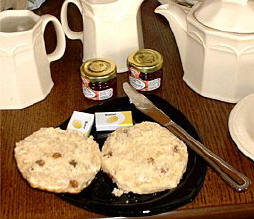
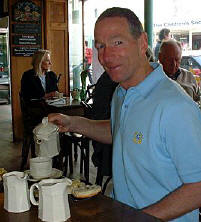 There
is the more traditional seating area in the old part of the shop, but there has
now recently opened a nice new modern area to the rear of the shop which affords
pleasant views into the garden. Interestingly in the new area there is the
original water well to the property from where water would have been drawn. This
brick lined deep well is covered with a glass panel so that you can still look
down and see your reflection in the the water at the bottom.
There
is the more traditional seating area in the old part of the shop, but there has
now recently opened a nice new modern area to the rear of the shop which affords
pleasant views into the garden. Interestingly in the new area there is the
original water well to the property from where water would have been drawn. This
brick lined deep well is covered with a glass panel so that you can still look
down and see your reflection in the the water at the bottom.
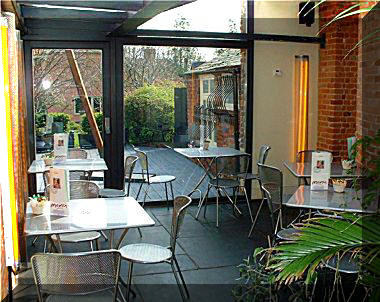 I
sat in the old shop and had good views out into the town streets where there
were a few market stalls down the pedestrian street opposite to the tearoom.
There are a few antique shops in the town giving an added pleasure to this
delightful Suffolk town.
I
sat in the old shop and had good views out into the town streets where there
were a few market stalls down the pedestrian street opposite to the tearoom.
There are a few antique shops in the town giving an added pleasure to this
delightful Suffolk town.
Twyfords
Exchange Square
Beccles
Suffolk
NR34 9HL
Tel: 01502710614
Click here for
Local Map
Map courtesy of www.streetmap.co.uk
To review past newsletters, just follow this link:
Past newsletters.
To subscribe to this free newsletter -
Click here